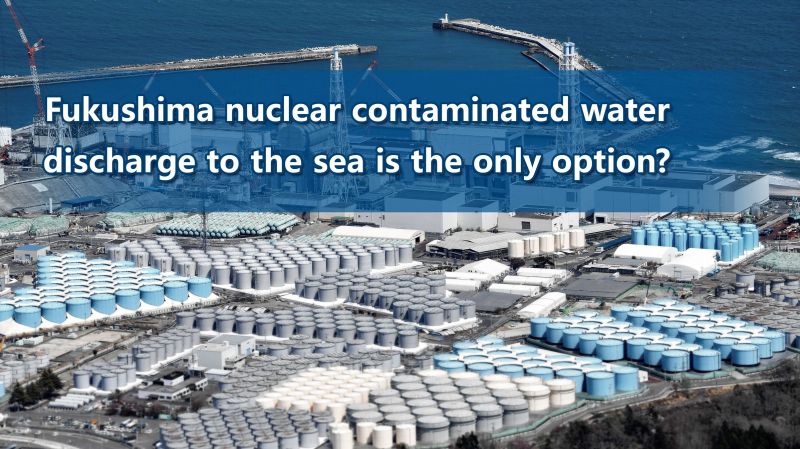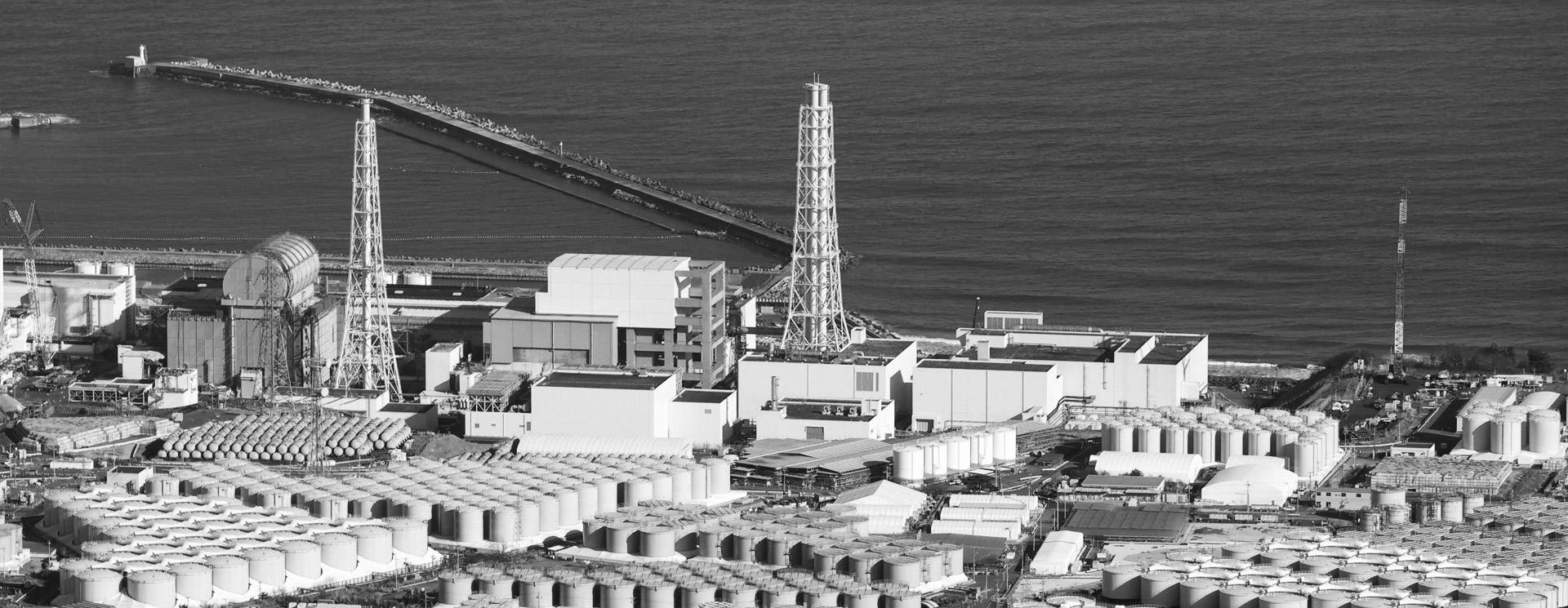
Vedio link: https://mp.weixin.qq.com/s/UHxraAXXSP3sy4crSmwsRg
福岛核污染水排海是唯一选择?
主持人:各位,这里是绿色江南《福岛核污染水专题》访谈面对面,我是主持人雨歌。
福岛核事故后,日本政府为储存用来冷却熔毁堆芯的大量海水,设置了约1000个能容纳1000-1300吨核污染水的储罐,目前所有储水设施的总容量接近140万吨,且已达极限。为处置这些核污染水,日本政府于2021年4月正式宣布,计划于 2023 年8月将130万吨由福岛核电站事故导致的核污染水通过海底隧道排放至距离海岸1公里附近的近海。此决定一出,立刻引起了国际社会的广泛关注。今天我们邀请到了绿色江南创始人方应君主任谈谈日本为何选择将福岛核污染水排海。
主持人问:请问方主任,日本政府为何会选择将福岛核污染水排海?排海方案是否是日本政府的唯一选择?
方应君主任:其实在日本政府正式宣布将福岛核污染水排海之前,曾提出5种福岛核污染水处置方案,包括往岩石圈注射、海洋排放、蒸汽释放、氢气释放(也就是电解处理)和地下掩埋。
2013年12月4日,国际原子能机构审查团曾向日本污染水处理对策委员会提供了咨询意见,建议列出所有核污染水的处置方案并对其进行评估。针对这一意见,日本成立了含氚污染水特别工作组,并从2013年12月25日开始,评估提出的5种核污染水处置方案,考察每种方案的可行性,包括持续时间、费用、规模、二次污染、工作人员所受辐射照射等。该工作组于2016年6月3日发表了评估报告。
该评估报告显示,海洋排放相较于其他四种处置方案,消耗时间最短,经济成本最低,其他处置方案处理的资金成本是海洋排放的10倍,甚至超过70倍。在处置方案是否会造成二次污染方面,蒸汽释放、氢气释放均有可能产生二次污染,而包括海洋排放在内的其余3个处置方案的二次污染均是“无”。
在前几期的访谈中,我们提到过福岛核污染水经过简单处理之后,仍有包括氚、碳14、钴60和锶90等大量放射性核素残留,一旦排海,除了污染海洋生态环境之外,还会通过海洋食物链在人体中富集,对人类的生存安全产生潜在威胁。显而易见,该评估报告的专业性有待验证。
我们发现,福岛核污染水并非到了必须马上处理、无处可存的地步,福岛县有大量的土地空间可以建造更多储存罐用来储存未来30年的核污染水,目前我们看见的日本政府在福岛建造了1000多个储存罐用来储存130多万吨核污染水,未来30年还将以每天140吨的核污染水增加量计算,也就是说新增的核污染水在150万吨左右,日本政府再建造1300个左右的贮罐即可满足未来30年的需求。随着时间的推移,这些储存罐中的核污染水多数的放射性核素将安全渡过半衰期,对环境和人类的危害程度将会大大降低。
因此,核污染水的处置方式是否安全、可控完全取决于日本政府的态度。海洋是人类的共同财产,福岛核污染水处置问题不仅关乎到日本本土,更关乎到全球。希望日本政府在处置福岛核污染水切勿为了所谓的经济成本而忽视了全人类的切身利益,更应从国际形象和国家责任角度出发,不能让全人类为福岛核事故“买单”,那将是一个全球悲剧性的灾难。
主持人:日本核污染水排海事关海洋环境安全和人类生命健康。核事故产生的核污染水与核电站正常运行产生的废水性质完全不同,不能相提并论。向海洋排放核事故污染水在全球没有先例,这是一个科学问题,更是一个态度问题。日本政府应正视全球关切和周边邻居的担心和诉求,科学论证各种不同处理办法,做一个负责人的国家,做一个有担当的国家。
绿色江南将持续关注福岛核污染水排海计划的进展。
Fukushima nuclear contaminated water discharge to the sea is the only option?
Compere: Ladies and gentlemen, this is Lvse Jiangnan "Fukushima nuclear contaminated water topic" interview face-to-face, I am the host Yu Ge.
After the Fukushima nuclear accident, the Japanese government set up about 1,000 storage tanks capable of holding 1,000-1,300 tons of nuclear contaminated water in order to store the large amount of seawater used to cool down the melted reactor core, and the total capacity of all the water storage facilities is currently close to 1.4 million tons and has already reached its limit. In order to dispose of this nuclear contaminated water, the Japanese government formally announced in April 2021 that it planned to discharge 1.3 million tons of nuclear contaminated water caused by the Fukushima nuclear power plant accident in August 2023 through a submarine tunnel to the offshore near 1 km from the coast. This decision immediately aroused widespread concern in the international community. Today we invited Mr. Fang Yingjun, founder of Lvse Jiangnan, to talk about why Japan chose to discharge Fukushima nuclear contaminated water into the sea.
Compere: May I ask Mr. Fong why the Japanese Government has chosen to discharge Fukushima nuclear contaminated water into the sea? Is the sea discharge option the only choice for the Japanese government?
Fang Yingjun: In fact, before the Japanese government formally announced the discharge of Fukushima nuclear contaminated water into the sea, it had proposed five options for the disposal of Fukushima nuclear contaminated water, including injection into the lithosphere, oceanic discharge, steam release, hydrogen release (also known as electrolytic treatment) and underground burial.
On December 4, 2013, the International Atomic Energy Agency Review Mission had provided advice to Japan's Contaminated Water Disposal Countermeasures Committee, recommending that all disposal options for nuclear contaminated water be listed and evaluated. In response to this advice, Japan established the Task Force on Tritium-Containing Contaminated Water and, from December 25, 2013, evaluated the five proposed disposal options for nuclear contaminated water, examining the feasibility of each option in terms of duration, cost, scale, secondary contamination, and radiation exposures to staff. The task force issued its June 3, 2016, assessment report.
The assessment report shows that oceanic emissions have the shortest consumption time and the lowest economic cost compared to the other four disposal options, and that the capital cost of the other disposal options is 10 times or even more than 70 times that of oceanic emissions. In terms of whether the disposal options will cause secondary pollution, vapor release and hydrogen release are likely to produce secondary pollution, while the remaining three disposal options, including oceanic discharge, have "no" secondary pollution.
In previous interviews, we mentioned that after simple treatment of Fukushima's nuclear contaminated water, a large number of radionuclides, including tritium, carbon 14, cobalt 60 and strontium 90, still remain. Once discharged into the sea, in addition to contaminating the marine ecosystem, it will also be enriched in human beings through the marine food chain, thus posing a potential threat to the survival and safety of human beings. Obviously, the professionalism of the assessment report has yet to be verified.
We found that the Fukushima nuclear contaminated water is not to the point that it must be immediately dealt with, there is nowhere to store, Fukushima Prefecture has a lot of land space can be built more storage tanks used to store the nuclear contaminated water for the next 30 years, at present, we see that the Japanese government in Fukushima built more than 1,000 storage tanks used to store more than 1.3 million tons of nuclear contaminated water, in the next 30 years will be 140 tons of nuclear contaminated water per day, an increase of 140 tons of nuclear contaminated water per day. In the next 30 years, there will be an increase of 140 tons of contaminated water per day, which means that the additional contaminated water will be around 1.5 million tons, and the Japanese government will have to build another 1,300 storage tanks to meet the demand in the next 30 years. With the passage of time, most of the radionuclides in the contaminated water in these storage tanks will safely pass their half-life, and the degree of harm to the environment and human beings will be greatly reduced.
Therefore, whether the disposal of nuclear-contaminated water is safe and controllable depends entirely on the attitude of the Japanese Government. The ocean is the common property of mankind, and the disposal of contaminated water from Fukushima is not only a matter of concern to Japan, but also to the whole world. It is hoped that the Japanese Government will not neglect the immediate interests of all mankind for the so-called economic cost in disposing of the Fukushima nuclear contaminated water, and should start from the perspective of international image and national responsibility, so as to prevent all mankind from "paying the bill" for the Fukushima nuclear accident, which will be a global tragic catastrophe.
Compere: The discharge of nuclear-contaminated water from Japan into the sea has a bearing on the safety of the marine environment and human life and health. The nature of nuclear contaminated water from nuclear accidents and wastewater from the normal operation of nuclear power plants is completely different and cannot be compared. The discharge of contaminated water from nuclear accidents into the sea has no precedent globally, and it is a scientific issue and, more importantly, a matter of attitude. The Japanese government should face up to the global concern and the worries and demands of the neighboring countries, scientifically prove the different treatment methods, and be a responsible country and a responsible country.
Lvse Jiangnan will continue to monitor the progress of the Fukushima nuclear contaminated water discharge program.
福島原発汚染水の海洋放出は唯一の選択肢か?
司会:皆さん、ここは緑色江南「福島原発汚染水特集」対面インタビュー、私は司会の雨歌です。
福島原発事故後、日本政府は、溶融した原子炉の炉心を冷却するために使用された大量の海水を貯蔵するため、容量1,000~1,300トンの核汚染水貯蔵タンクを約1,000基設置ししました。 現在、すべての貯水施設の総容量は140万トンに迫り、限界に達しています。日本政府は2021年4月、福島原発事故による核汚染水130万トンを、2023年8月に海底トンネルを通して海岸から1km付近の沖合に放出する計画を正式に発表しました。この決定は直ちに国際社会から広く注目を集めました。本日は、緑色江南の創設者の方応君主任をお招きし、なぜ日本は福島の核汚染水を海に流すことを選んだのかお話を伺います。
司会者:方主任にお聞きしたいのですが、なぜ日本政府は福島原発の汚染水を海に流すことを選んだのでしょうか? 日本政府にとって、海洋放出という選択肢しかないのでしょうか?
方主任:実際、日本政府は福島原発の汚染水の海洋放出を正式に発表する前に、福島原発の汚染水処理について、岩石圏への注入、海洋放出、蒸気放出、水素放出(電解処理)、地下埋設の5つの選択肢を提示しました。
2013年12月4日、国際原子力機関審査団は、日本汚染水処理対策委員会に対し、原子力汚染水のすべての処分選択肢を列挙し、評価するよう勧告する助言を行いました。この助言を受け、日本は「トリチウム含有汚染水対策タスクフォース」を設置し、2013年12月25日から、核汚染水の処分方法として提案された5つの選択肢について、期間、コスト、規模、二次汚染、職員の被ばくなど、それぞれの選択肢の実現可能性を検討し、評価を行いました。 タスクフォースは2016年6月3日に評価報告書を発表しました。
評価報告書によれば、海洋排出は他の4つの処分方法と比較して、消費期間が最も短く、経済的コストが最も低いです。他の処分オプションの処理にかかるコストは、海洋排出の10倍、あるいは70倍以上になります。処分方法が二次汚染を引き起こすかどうかという点では、蒸気放出や水素放出による二次汚染の可能性はあるが、海洋排出を含む残り3つの処分方法は二次汚染が「ない」となりました。
以前のインタビューでは、福島の汚染水を簡易処理した後も、トリチウム、炭素14、コバルト60、ストロンチウム90など多くの放射性核種が残っていることを紹介しました。いったん海に放出されれば、海洋生態系を汚染するだけでなく、海洋食物連鎖を通じて人体にも濃縮され、人類の生存と安全を脅かす可能性があります。 明らかに、評価報告書の専門性はまだ検証されていません。
私たちは、福島の核汚染水はすぐに処分しなければならない段階にはなく、保管する場所も見つけられることを発見しました。 福島県には、今後30年間の汚染水の貯蔵タンクを建設するための土地がたくさんあります。 日本政府は福島県に1000基以上の貯蔵タンクを建設し、130万トン以上の汚染水を貯蔵しています。今後30年間で、1日あたり140トンの汚染水が増加するため、追加的な汚染水の量は約150万トンになります。 日本政府は、約1300基の貯蔵タンクを増設することで、今後30年間の需要を満たすことができると思います。時間が経てば、これらの貯蔵タンク内の核汚染水に含まれるほとんどの放射性核種は安全に半減期を過ぎ、環境と人間への害のレベルは大幅に減少できます。
原発汚染水の処分が安全でコントロール可能かどうかは、すべて日本政府の姿勢にかかっています。海は人類共有の財産で、福島の核汚染水の処理は、日本のみならず全世界の関心事です。日本政府が福島の核汚染水処理において、経済的コストのために全人類の重要な利益を犠牲にしないことが望んでいます。さらに日本は、国際的なイメージや国家責任の観点から、福島原発事故の代償を全人類に「払わせる」ことがあってはならないです。
司会:日本からの原子力汚染水の海洋放出は、海洋環境の安全や人間の生命と健康にか関わります。 原発事故による核汚染水と原発の通常運転による排水は性質が全く異なり、比較することはできません。原発事故による汚染水の海洋放出は、世界的にも前例がなく、科学の問題だけではなく、さらに重要なのは姿勢の問題です。日本政府は、世界的な懸念や近隣諸国からの不安や要求を直視し、原子力廃水の幾つの処理方法を科学的に検証するべきです。日本は責任ある国になることを願っています。
緑色江南は福島核汚染水排出計画の進展に引き続き注目していきます。
Contentsource: Lvse Jiangnan WeChat public account
